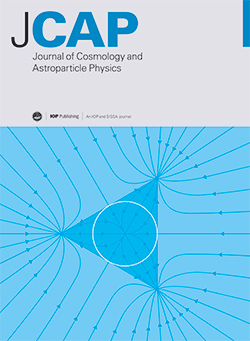The impact of large-scale galaxy clustering on the variance of the Hellings-Downs correlation: theoretical framework
IF 5.3
2区 物理与天体物理
Q1 ASTRONOMY & ASTROPHYSICS
Journal of Cosmology and Astroparticle Physics
Pub Date : 2025-03-06
DOI:10.1088/1475-7516/2025/03/011
引用次数: 0
Abstract
While pulsar timing array experiments have recently found evidence for the existence of a stochastic gravitational wave (GW) background, its origin is still unclear. If this background is of astrophysical origin, we expect the distribution of GW sources to follow the one of galaxies. Since galaxies are not perfectly isotropically distributed at large scales, but follow the cosmological large-scale structure, this would lead to an intrinsic anisotropy in the distribution of GW sources. In this work, we develop a formalism to account for this anisotropy, by considering a Gaussian ensemble of sources in each realization of the universe and then taking ensemble averages over all such realizations. We find that large-scale galaxy clustering has no impact on the expectation value of pulsar timing residual correlations, described by the Hellings-Downs curve. However, it introduces a new contribution to the variance of the Hellings-Downs correlation. Hence, the anisotropic distribution of sources contributes to the amount by which the measurements of pulsar timing residual correlations, in our single realization of the universe, may differ from the Hellings-Downs curve.求助全文
约1分钟内获得全文
求助全文
来源期刊

Journal of Cosmology and Astroparticle Physics
地学天文-天文与天体物理
CiteScore
10.20
自引率
23.40%
发文量
632
审稿时长
1 months
期刊介绍:
Journal of Cosmology and Astroparticle Physics (JCAP) encompasses theoretical, observational and experimental areas as well as computation and simulation. The journal covers the latest developments in the theory of all fundamental interactions and their cosmological implications (e.g. M-theory and cosmology, brane cosmology). JCAP''s coverage also includes topics such as formation, dynamics and clustering of galaxies, pre-galactic star formation, x-ray astronomy, radio astronomy, gravitational lensing, active galactic nuclei, intergalactic and interstellar matter.
 求助内容:
求助内容: 应助结果提醒方式:
应助结果提醒方式:


